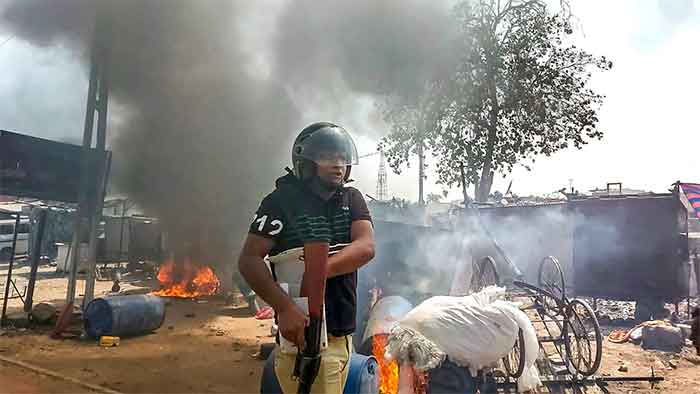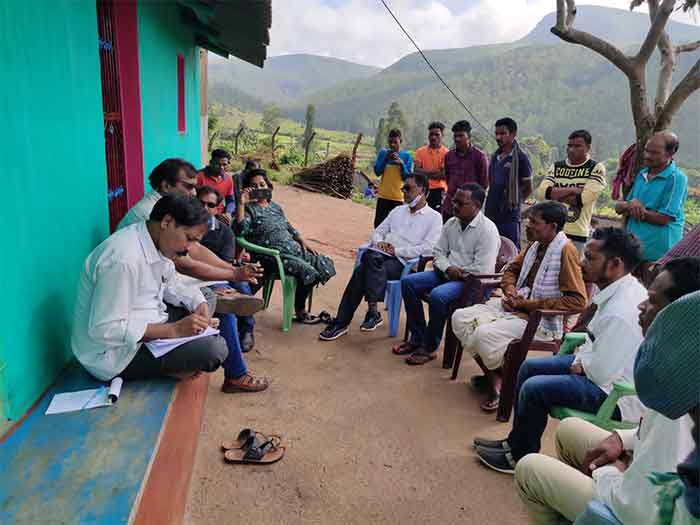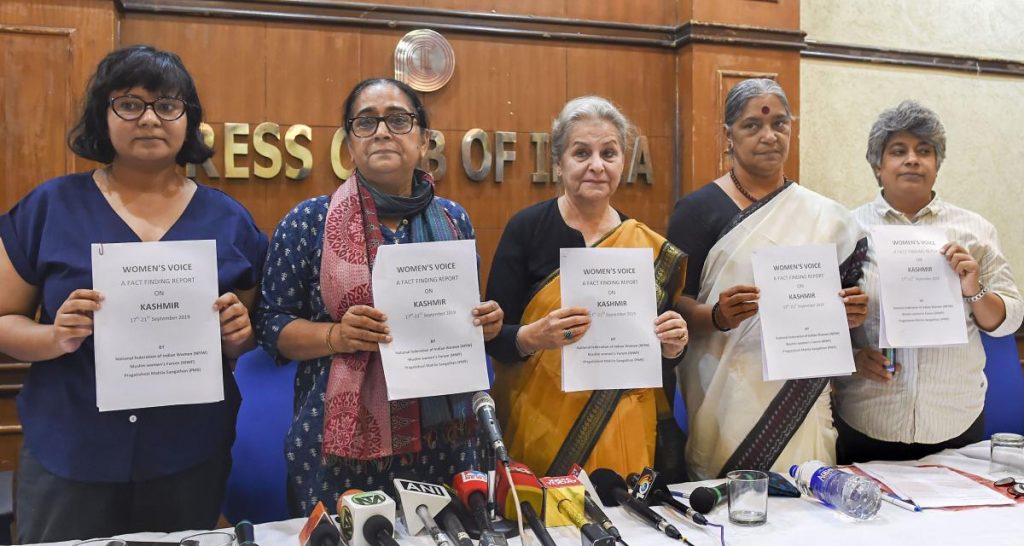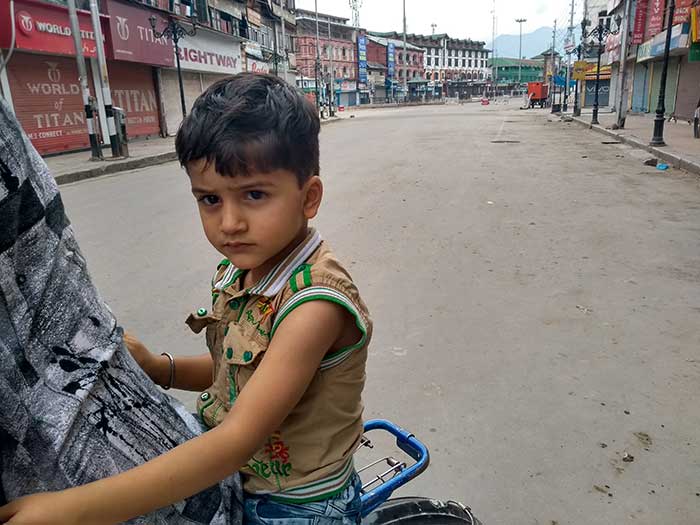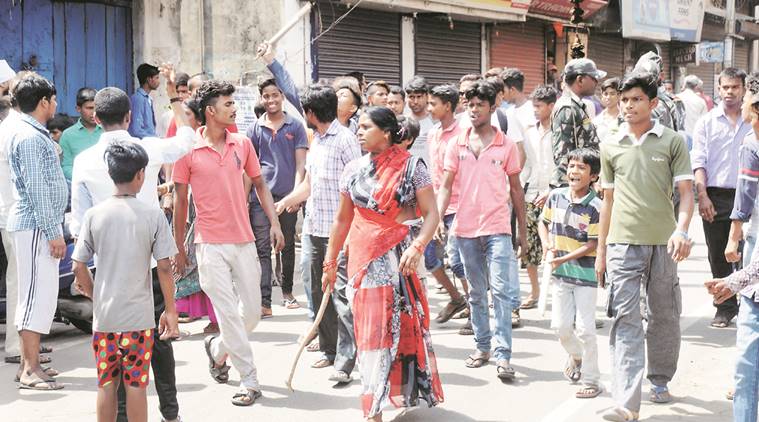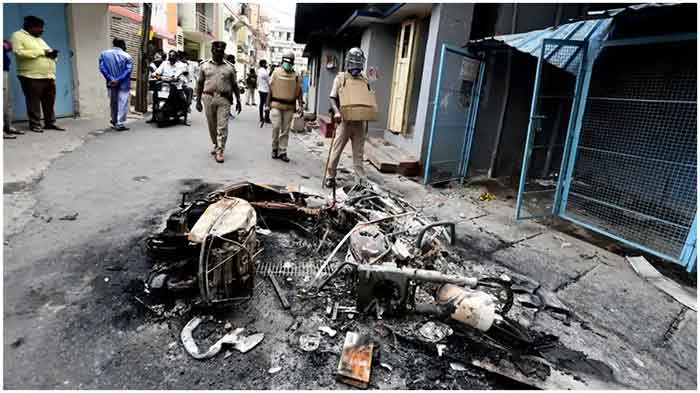
Report of the fact finding into the violence and it’s Aftermath at D.J. Halli and K.G. Halli by Bangalore Civil Society Organisations
An Executive Summary
“Whoever put the post out is wrong. Not registering the complaint is wrong. The violence is wrong.”
Sameena, a local resident, Kavalbyrasandra
The Action, Reaction and its Aftermath
On August 11, 2020, an incendiary image posted on the same date at 5:46 pm by P. Naveen Kumar, who is a resident of Kaval Byrasandra and MLA Akhanda Shrinivas Murthy’s nephew, set off a chain of events including violence at the Devarajeevanahalli (D.J. Halli) and Kadugondanahalli (K.G. Halli) Police Stations. Shortly after the post, two groups independently filed a complaints between 7.00pm and 7.30 pm at these two police stations against Naveen for his post. On account of the perceived delay in registration of the FIRs and police action against Naveen a crowds began to gather and increased at both police stations. A crowd of 200 – 300 persons gathered at 8.00 pm in Kaval Byrasandra, attacked Naveen’s house, and the MLA Akhanda Shrinivas Murthy’s house between 9.15 pm and 10.00 pm. The crowd at the police stations had, in the meantime, had grown violent and attacked the stations, vehicles, and police, resorting also to arson. After some delay in taking action, the police resorted to firing in D.J Halli in which four young men were killed. In Kaval Byrasandra, the crowd also conducted seemingly random attacks on private properties particularly where the violence carried on till 12.30 am and stopped with a flag march staged by the Garuda force.
On August 12, 2020 immediately after the incident, prohibitory orders was imposed under Section 144, and approximately 400 – 500 persons were arrested across 68 FIRs registered in the two police stations, thought he exact numbers are yet not forthcoming. Many arrests have occurred after mid night, creating an atmosphere of fear and anxiety among the locals in the areas.
The Fact Finding Initiative: Its Intent, Process and Concerns
To inquire into the incident and its aftermath, a twenty-four-member team comprising researchers, civil society activists, human rights organisations, and advocates visited Devarajeevanahalli, Kadugondanahalli and Kaval Byrasandra from August 20 – September 1, 2020. An announcement of the fact finding was also released and widely covered by the media in which any information related to the violence was sought through an email address and phone number that was also made public. The broad objective of the team was to understand the background and events that unfurled on the night of August 11, 2020, shed light on the incident and document facts that contributed to the violence at the police stations, as well as the subsequent mob violence, attacks, and arrests that occurred in these areas. Pertinently, the team examined the role of the media and social media surrounding the incident and attempted to understand the broader socio-economic context of the region within which this violence took place.
Our concern was to unearth the truth in an unbiased manner and contextualise both the provocation and the violence within a constitutional and democratic perspective. We are aware that fact finding in such conflict situations is a critical exercise that requires extraordinary care and sensitivity, for while holding law breakers accountable it also needs to be directed towards restoration of and social justice and peace while extending relief and comfort to those affected by the violence. We were mindful therefore that it would need to be an earnest exercise in effort as it is in perception. In the course of carrying out this Fact Finding Mission we realised it
would be a challenge to people belonging to all faiths, particularly in this instant, the Hindus and Muslim – each of who have a constitutional obligation to protect and uphold the democratic and plural nature of our Constitution. The report is presented to the government and the citizens with the intention of holding the state and its various arms responsible and accountable for its acts of omission and commission while also ensuring peace and justice in conflict situations and to initiate a process of democratic dialogues within and between diverse communities.
The team visited families of those who were killed in the police firing, who sustained injuries, who were arrested, and those impacted by the violence and vandalism across religious communities. The team also visited shops, vendors, departmental stores, domestic workers, organisations working on relief, community leaders including religious leaders and political representatives, media persons who were injured during the incident, police officers from the area’s police stations including the DCPs, ACP, Naveen’s family, Dalit groups in the area, as well as groups that filed the initial complaints against Naveen’s post. The team also attempted to meet the Commissioner and the hospital where the injured were taken. The team has tried to ensure to met a representative number of all persons and organisations who have witnessed the incident and events thereafter.
Summary Findings
Having conducted a thorough inquiry into the incident, documenting several testimonies, and gathering evidence from all those involved across the spectrum, the team has inferred the following facts
a. The Facebook Post: Naveen’s post crosses the constitutional protection encompassing free-speech, and amounts to hate speech against the Muslim community. Despite the fact that it was clearly meant to incite, his intent and motive in publishing the post has not been sufficiently probed either by the police or even addressed by the media, which have instead chosen to focus largely on the violence which is more visible and sensational.
b. The Mob Violence: The role of the mob, in perpetrating the violence, whether on the D.J. Halli and K.G. Halli police stations or on public and private property including the houses of Naveen and Akhanda Sreenivas Murthy, are undeniable and unjustifiable. 3 lives were lost in the police firing, another subsequently to injuries while several, including the police, were injured. It is noticed however that the mob appeared to be not directed by any visible leadership. The violence has to be dealt with as a law and order problem where due process is followed. Along with this, accused also have rights which need to be respected. All this also needs to be handled with sensitivity and care to ensure that basic human rights and social harmony are not further eroded and violated. Unfortunately despite the fact that all spoken to within the community condemned the violence as totally unnecessary and as a result of which so many innocents are now paying the price,not giving credence and credibility to these voices we believe is part of the larger agenda of total criminalisation and demonisation of the entire community
c. Police Inaction: Not only did the police fail to act expeditiously and effectively on the post when small delegations approached the police station, but they also failed to intervene in effective ways in preventing the violence from escalating in D.J. Halli, K.G. Halli and in Kaval Byrasandra. The perceived delay in lodging the FIR, failure to assure firm legal action and the perception that this was due to the MLA’s intervention cannot be turned a blind eye to. The police ought to have taken more proactive measure to prevent the crowd from gathering including urgently bringing in additional reinforcements that would have helped to disperse the mob before it spiralled out of control. The police seem to have abandoned the situation like in Kaval Byrasandra where despite repeated phone calls to the police station, the police either came late or when they did arrive at the site of violence, did so in small insiginificant numbers.
There was an intelligence failure in the State machinery’s reaction to the incident, the police are responsible for a delayed response in registering the FIR against Naveen, which resulted in a discontent crowd swelling at the stations.
d. Was the mob violence communal or political; pre-planned, premeditated or spontaneous or opportunistic: There is a lack of substantial evidence to suggest that the mob violence was communal in nature, in that it specifically targeted the Hindu community or that it was premeditated and pre-planned. From the manner in which it unfolded it appears as all we spoke to expressed that this was indeed a local and spontaneous incident that had been taken advantage of by different political parties for immediate political gains which included the upcoming corporator elections. It is accepted by various groups that Muslim youth assisted in the protection of Hindu and Christian families and the homes and vehicles of Hindus. They formed human chains outside the Hanuman temple as also the police station to keep away the mob. In Kaval Byrasandra a property belonging to a Muslim was vandalised and damaged while vehicles of Muslims were also burnt regarding which they have filed police complaints. While some individuals and houses of Hindus were randomly targeted, it was felt that this moment was used to seek personal vendetta on some families and not communal in nature. Many Hindu families whose houses were vandalised shared that it was the local Muslim families who also helped protect their property. While one short street in that entire area where there are a sizeable number of Hindus residents was also targeted for attacks, this vandalism did not spread to other Hindu houses in the area. More important as almost everybody reported there have been no incidents of Hindu – Muslim violence in the area and the communities have lived together in relative peace and harmony. Therefore this could not be established as either a communal or a pre- planned attack. It is the subsequent narrative built up by the media and government pronouncements that are infact labelling it as a communal act against
e. Post Violence Police Actions: The imposition of an prohibitory orders under Section 144 was a ubiquitous punishment to those in the areas, who were met with verbal and physical abuse when they attempted to leave their homes. Several arbitrary arrests were carried out in the middle of the night, that has created an atmosphere of fear in the areas. The families of those arrested have not been informed of the arrest or whereabouts of their loved ones. Several requirements of providing information of the arrest to a nominated person, or preparation of an arrest memo, have not been followed, leading to a violation of the rights of the accused. The unwarranted invocation of the UAPA in the present case evidences its misuse and abuse to further a communal narrative against the Muslim community, and target the SDPI. The State Government has moved the Karnataka High Court for appointment of Claims Commissioner to initiate the process of assessment of damage to properties in the violence. Karnataka High Court even while passing the order appointing the Claims Commissioner has held that they are not concerned with the correctness or otherwise of the allegations made in the FIRs and that the same is a matter of investigation and enquiry. It must be stated that this process cannot be completed until the criminal trials are concluded since anything else would affect the fundamental right of the accused to a free and fair trial.
It must be pointed out that contradictorily enough in the midst of all this, the State government has decided to withdraw 62 criminal cases pending against sitting BJP MPs and MLAs and BJP leaders, despite the Director General and Inspector General of Police, the Director of Prosecution and Government Litigation and the Law Department recommending against it.
f. Violation of Post-arrest procedures: Required procedures such as physical production of the accused, not merely through video-conferencing, and even Video- Conferencing Hearing Rules, were not followed. The requirement of application of mind by the Magistrate in remanding those arrested was not entirely adhered to, as remand has been granted in a routine
g. Role of Social Media: Facebook failed to take action against Naveen’s post that amounts to hate speech. Several sections of the media have mis-portrayed the incident in a communal light by spinning conspiracy theories and targeting the Muslim community. Further, on a detailed analysis of information regarding the post and the events of August 11, circulated on various social media platforms, it was found that several Instagram accounts of Muslims with several thousands of followers urged people to stay indoors and not fuel the tensions. There was the rapid spread of misinformation and selective facts, combined with divisive opinions nudging people towards generalised hate towards Muslims, including by accounts of influencers and personalities from the
h. Role of the Mainstream Media: By all accounts, barring a few exceptions like the English print media, media, print and television, English and Kannada, coverage of the events of August 11, have been biased and largely unsubstantiated. Unsubstantiated speculations (Some English print media however carried various perspectives and highlighted the pains of people wrongfully arrested) and suspicions fuelled by the Islamophobic and anti-Muslim orientation of media houses saw conspiracy theories being spun on a daily basis. The trial by media suspended in regard to those arrested the most basic principles of criminal jurisprudence, including the presumption of innocence and right to fair trial, and criminalised the entire Muslim community in these areas. Unsubstantiated and unproven allegations of the violence being communal and pre-planned, were presented in sensationalist
It is clear from this analysis that large sections of the Kannada media especially has attempted to consolidate an anti-Muslim sentiment among its readers and viewers. Its coverage lacked objectivity, and abandoning any shred of journalistic scepticism, sensationalist reporting sought to peddle a communal agenda most blatantly.
j. Post Violence political fallout: While the violence itself was spontaneous it also appeared that not only was it taken advantage of for short term political gains but is also being exploited subsequently for political consolidation on communal lines. There is an effort to consolidate the discontent within the Muslim youth, given the fact that the Muslim community faces a veritable onslaught from the right-wing forces and feels let down by the democratic institutions. It is also a reality that forces like RSS and Bajrang Dal, have been trying to divide the communities on religious lines, and, post the violence are trying to give the riot a communal colour and deepen the sense of victimisation among the Hindu community. Teams from the RSS/BJP have come to the area and are apparently attempting to speak only to the Hindu households impacted to help them get legal help and compensation. The growing presence and influence of RSS in Dalit pockets of these areas is indicative of its political intent of polarising the region on communal lines.
The arbitrary use of UAPA and proposal to refer the case to the NIA appears to be part of a pattern on the part of the ruling government to stereotype the entire Muslim community as being anti National and traitors to justify all suspension of due process and safeguarding basic human rights with regard to their arrest and subsequently trial and convictions.
In summary it appears that post the violence instead of following due to process to identify those youth involved in the violence, the incident has been used to subject the entire community to arbitrary arrests, targeted hate speech, and alienation without any serious attempt being made to investigate the role of the original facebook post which infact set off these chain of events.
Recommendations
Based on the aforementioned findings, the Committee raises the following recommendations:
To the State Government:
- The scope of the investigation against Naveen’s Facebook post must be widened, including an inquiry into the failure of the police to take immediate action against Naveen.
- The failure of the police to take steps to communicate with and control the crowd must be investigated.
- The intelligence failure to predict and prevent the violence must be
- An immediate socio-economic survey must be conducted in the two concerned police station limits to assess the loss of livelihoods, nutrition, health and shelter post the lock-down and measures must be taken to ensure that livelihood needs, shelter needs and nutritional needs are addressed
- The Justice Rajinder Sachar Committee Report and 15 Point Programme for the Welfare of Minorities must be
- Steps must be taken to ensure that the spread of Islamophobia is immediately stopped. Efforts to spread hate and misinformation about the Muslim community has resulted in the alienation and isolation of the community. It is the duty of the State to take all steps towards ensuring fraternity and promoting social harmony and prevent further communalisation of the
- Form Peace Committees that comprise all communities to restore peace in the
- The charges under the Unlawful Activities Prevention Act (UAPA) invoked against the Accused must be immediately
- The procedure as laid down in the law must be ensured and there must be a thorough investigation, done in a transparent manner ensuring that the rights of all accused are not violated and respecting the basic presumption of
- There must be an enquiry conducted into the arrest of persons, to ensure that all innocent persons are immediately
- All injured persons who are presently in jail must be ensured that immediate medical treatment
- The process to recover damages for the losses suffered must be done only after the conclusion of trail and must in no way jeopardize the right of the accused to a fair trial and the presumption of innocence
- The State must restore the faith of residents of DJ Halli, KG Halli, and Kavalbyrasandra in its machinery by addressing the persistent fear over arbitrary
- Criminal action must be initiated against MLAs who engaged in hate
- The decision to withdraw 62 criminal cases against elected representatives must be cancelled, ensuring swift
To the Police
- All innocent persons who have been arrested must be released immediately after a preliminary
- The families of the accused persons must be informed regarding the cases against them and their
- The Hon’ble Supreme Court’s judgment in PUCL State of Maharashtra on extra- judicial killings must be complied with.
To the Media
- There must be a discussion on effective self-regulation in the media, especially broadcast
- Cease all sensationalising news in regard to the
- Communal reporting must be
- The Media must ensure strict adherence to the regulations governing the content, specifically on fair reporting, the prohibition on biased or half-truth reporting, and the prohibition on sensationalizing an
To the community leaders in the area
- The community leaders must encourage rational and critical debates on the role of religion in fostering democratic and constitutional values related to plurality, coexistence and compassion which are the foundations of a healthy
The Fact Finding Team
The Fact Finding Team Members comprised of Nina Nayak1 (Former Chairperson, Karnataka State Commission for Protection of Child Rights and former Member, National Commission for Protection of Child Rights), Cynthia Stephen (Independent Journalist and Policy Researcher), V. Nagaraj (State Convenor, Dalita Sangharsha Samiti (Samyojaka)), Mohanraj (State Convenor, Dalita Sangharsha Samiti (Bhimavada)), Advocate Niyaz Moosa (Association for Protection of Civil Rights, Karnataka), Leo Saldhana (Co-ordinator, Environment Support Group), Geeta Menon (Stree Jagruti Samiti), Prof. YJ Rajendra (President, People’s Union for Civil Liberties, Karnataka), Irshad Ahmed Desai (Movement for Justice), Manu Chowdhuri/ Madhu Bhushan (Gamana Mahila Samuha), Hebbal Venkatesh (State Convenor, Dalita Sangharsha Samiti, Karnataka), Vijay Kumar Seethappa (Swaraj Abhiyan, Karnataka), Firdouse Khan (Forward Trust), Gandhimathi K (All India Progressive Women’s Association), Tanveer Ahmed (Movement for Justice), Shanmugham P (Peoples Democratic Forum), Swathi Seshadri (All India Peoples Forum), Mallige (Karnataka Jana Shakti), Alwyn D’Souza (Indian Social Institute), Dr. Siddarth Joshi (Independent Researcher), Ganesh G (People’s Democratic Forum), and Shilpa Prasad (All India Lawyers Association for Justice)
1 As the field work for the fact finding began, Nina Nayak contracted COVID 19 and was not able to be a part of the process. However, she has read the report and endorses the same.
SIGN UP FOR COUNTERCURRENTS DAILY NEWSLETTER

